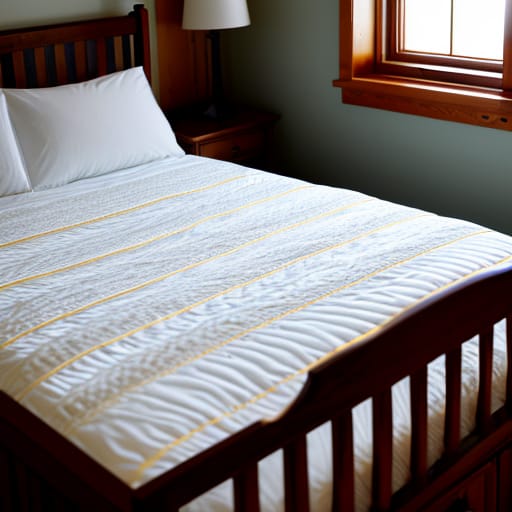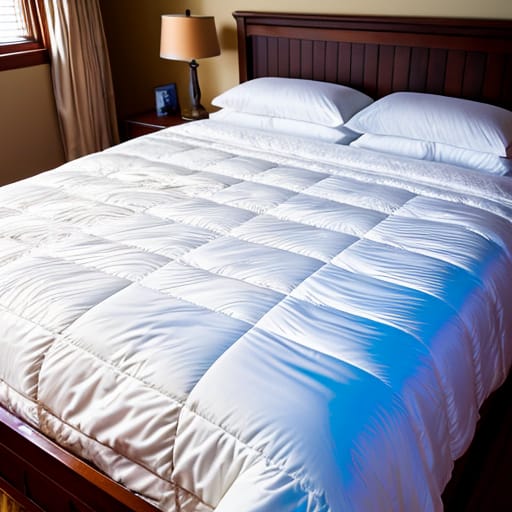Do you love snuggling under a warm, fluffy down comforter on a cold winter night? As cozy and comfortable as down bedding feels, proper care is essential for longevity and performance. We’ll cover everything you need to know as a beginner – from helpful facts about fill power and down proof fabrics to washing instructions and tips for choosing the best quality down. Read on for your complete guide on maintaining the dreamy comfort of your down comforter!
What Makes Down So Warm and Comfortable
Down comforters provide unbeatable warmth for their weight. But what exactly is down and why does it make such an effective insulator?
Down refers to the fine, fluffy clusters that sit underneath the rougher exterior feathers of ducks and geese. These soft-down clusters trap body heat, much like insulation in a house. They are exceptionally warm relative to their weight because they can loft and expand to create pockets of insulating air.
The fill power indicates the lofting ability of down. A higher fill power, from 800 up to 900, means more clusters and better insulation with less weight needed. For frigid northern winters, 800-fill and above is ideal, while 600-fill works better for milder climates.
As you search for that perfect Goldilocks level of cozy warmth, pay attention to fill power to find the right balance of fluffiness, durability, and affordability.
Getting the Warmth Just Right With Temperature Regulation
One key benefit of high-quality down is its amazing temperature regulation. Light, breathable down proof fabrics allow heat-releasing perspiration to pass through while trapping the down loft to prevent cool air from entering.
This makes down perfect for both warm sleepers who want ventilation and hot sleepers dealing with night sweats. The springy clusters expand or compress to release or retain heat as needed for personalized euphoric comfort all night long. For anyone struggling with temperature fluctuations that disrupt sleep, down can be the bed of clouds solution you’ve been dreaming of!
Understanding Down Comforter Warmth Ratings
With the right fill power selected for your climate, next comes choosing the appropriate warmth level. Down comforters typically come in the following weight classes from lightest to warmest:
- Ultra-light: Great for summer or warm climates
- Lightweight: For mild weather or warmer sleepers
- All-season: Works year-round in average temperatures
- Winter weight: Heaviest and toastiest for cold months
Within each class, higher fill power means more insulation from less filler material. So a 800-fill ultra-light comforter could keep a warm sleeper cozy on a winter night while still feeling airy and breathable.
Identifying Quality Down Construction
You’ll also want to evaluate the stitching and fabric when assessing down bedding quality. Look for these hallmarks of a well-made comforter:
- Baffle box design: Separate fabric compartments prevent shifting of fill
- Higher thread count cotton: Lightweight and breathable
Watch out for sewn-through boxes or low thread count synthetic fabrics which signal cheaper construction prone to deterioration.
When comparing comforters, check that the stated fill weight aligns with the expected warmth rating too. More ounces of down doesn’t automatically mean a warmer blanket if the fill power is low quality.

Can You Machine Wash Down? Proper Cleaning Methods
To enjoy your dear down comforter for years to come, proper washing is paramount. Start by checking the care label for cleaning instructions.
Recommended Washing Cycles
Most quality down is machine washable. Use these gentle settings to prevent damage:
- Cold water delicate cycle
- Mild detergent without bleach
- Low agitation speed for the spin cycle
Dry cleaning is still preferred for some higher end down, especially for frequent washes. The harsh solvents are gentler than home washing machines. But even dry clean only down bedding can typically handle an occasional extra gentle machine wash in a pinch.
Drying Guidelines
For machine drying, use low heat. Excessive heat risks compressing or clumping of the down clusters which reduces loft and insulation.
Ideally, dry flat or line dry. The fluffing and tossing required takes effort but fully restores that cloud-like feel! Some comforters suggest tennis balls in the dryer to help separate and redistribute the fill after washing.
Frequency
How often you wash depends on use and climate. Every 2-3 years is fine for light use in a temperate environment. But hot, humid areas or frequent sweaty sleepers may need annual washes.
Spot clean gentle spills right away with a damp cloth and mild soap before they set in deeper.
Storing to Maintain Loft
Proper storage between seasons prevents dust and dirt from compressing the down over time.
Cedar chests make ideal storage containers, as cedar’s acidic aroma naturally repels insects and moths. Alternately, breathable cotton or mesh bags work too.
For everyday use, protect your comforter inside a duvet cover. This helps keep body oils and sweat from degrading the downproof shell fabric over time.

Dive Into Down: Head First Into Cloud-Like Comfort!
Now that you know what to look for in terms of fill, fabric, construction, and care for down comforters, it’s time to start checking out options!
As you evaluate different comforters, consider these key criteria:
Warmth needs based on your climate, room temperature, and sleep preferences
Loft maintenance from proper washing, drying, and storage
Long-term value for investment pieces compared to disposable bedding
While the initial cash outlay for quality goose down is higher, you’ll reap rewards in durability and restful sleep for years to come. Treat your bedding as the essential creature comfort it is! Prioritize fill power, materials, and workmanship appropriate to your budget. Then guard your purchase by mastering the care regimen through vigilant label reading.
Frequently Asked Questions
What is the warmest down comforter for winter?
For freezing temps, look for a comforter with at least 800 fill power and winter weight fill. Higher fill power provides ultralight warmth for frigid nights. Quality baffle-box stitching keeps insulation evenly distributed.
How do I make my down comforter fluffy again?
Proper drying restores loft and fluff after washing. Machine dry on low or no heat. Remove promptly and vigorously shake out all baffles. Finish by laying flat for several hours, smoothing and rotating periodically. Tennis balls in the dryer also help redistribute fill.
What thread count is best for down comforter?
200-500 thread count cotton shell fabrics balance breathability with durability. Lower thread counts risk poking feathers through over time while higher counts inhibit ventilation. Carefully balanced thread counts support both down-proofing and air circulation.
Can I put a down comforter in a duvet cover?
Yes, duvet covers protect down comforters from body oils and soiling. All styles of down bedding benefit from removable covers for easy washing. Just ensure dimensions match, with the comforter about 2 inches longer and wider than the duvet to allow for shifting in the night.
How do you know if down comforter is good quality?
Inspect both shell fabric and fill material closely. Quality comforters should list percentages of down versus feathers. 75-95% down content ensures both durability and warmth. Check for baffle box construction and a 200+ thread count cotton shell. Desired fill power depends on seasonal needs.
Why are down comforters so expensive?
Ethically sourced premium down requires specialized harvesting and processing to yield maximum loft and durability. Markets supporting fair trade for rural down producers helps justify costs. With vigilant care and storage, quality comforters deliver over a decade of daily coziness and insomnia-banishing comfort.
How often should you replace a down comforter?
Expect around 10 years from high-end down with proper care. Budget down may compress irreparably after 5 years. Replace any comforter with visible deterioration – poking feathers, flattened sections, ripped stitching, stained fabric, or musty odors. Increase lifespan by using duvet covers, careful washing, and restoring fluff after cleaning.








